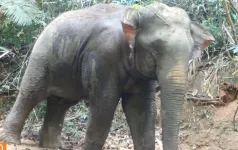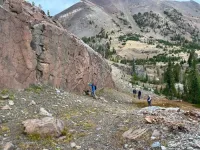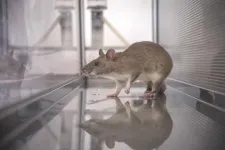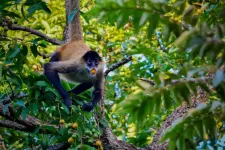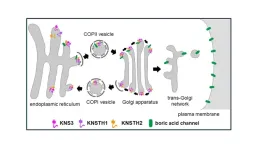Editors please note: Use these links to access camera trap footage and the full report.
The report, released today by the Cambodian Ministry of Environment (MoE), the United States Agency for International Development (USAID), Conservation International and partners, documents 65 bird species, 38 mammal species, and five reptile species including the Endangered dhole (Cuon alpinus), one of the last remaining predators in Cambodia, and its abundant prey base including wild pig (Sus scrofa), and northern red muntjac (Muntiacus vaginalis).
The study detected other rare and elusive species including Asian elephant (Elephas maximus), clouded leopard (Neofelis nebulasa), marbled cat (Pardofelis marmorata), Asiatic golden cat (Catopuma temminckii), sun bear (Helarctos malayanus), and Asiatic black bear (Ursus thibetanus).
With over 95% of its forests intact, the Central Cardamom Mountains Landscape remains one of the country's least deforested areas. Recognized as one of the Global 200 ecoregions, this landscape is home to nearly 4,000 Chourng and Por Indigenous peoples, supports more than 500 species, stores a significant volume of carbon and provides a critical watershed for over 30,000 people downstream, sustaining agriculture and fisheries, including the Tonle Sap Lake, one of the world’s largest inland fisheries.
The Central Cardamom Mountains face threats from illegal logging, forest clearing for agriculture, poaching, and the unsustainable overuse of natural resources such as wood collection for charcoal, overfishing, and sand dredging.
Conservation International’s Research Lead, THAUNG Ret, said, “This survey confirms the Central Cardamoms as a globally significant biodiversity hotspot and conservation priority. While the 108 species recorded by the camera traps are impressive, they represent just a fraction of the animals present. These cameras couldn’t capture insects, canopy habitat birds, aquatic species like amphibians and fish. Extensive research is needed to truly understand the species richness and adequately conserve this treasure trove of biodiversity."
His Excellency Dr. EANG Sophalleth, Minister of Environment emphasized the importance of the habitat conservation collaboration in protecting this habitat stating, “The survey’s result reaffirm that Cambodian forests are not just a landscape, but a vital sanctuary for our planet’s diverse species. It reflects the positive result of the efforts that the Ministry of Environment has been putting through the Circular Strategy on Environment which focus on biodiversity protection and habitat restoration.”
H.E. Minister continued, “This also underlines the importance of our collaborative efforts, which are crucial to the Royal Government of Cambodia (RGC)’s Pentagon Strategies and our commitment under the Convention on Biological Diversity. Protecting our biodiversity is not just an obligation as it is a testament to our dedication to sustainable development and environmental stewardship.”
The survey is the result of a collaboration between the Royal Government of Cambodia (RGC), the United States Agency for International Development (USAID), Legacy Landscapes Fund (LLF), Procter & Gamble Co. (P&G), Conservation International, Indigenous People and Local Communities, and other partners. It has engaged and enhanced stakeholders' understanding of the invaluable ecological services provided by the Central Cardamom Mountains Landscape, including robust biodiversity support, climate change mitigation, freshwater provision, and sustainable livelihood.
OUM Sony, Country Director of Conservation International Cambodia, stated, "The study establishes a critical baseline for future wildlife population monitoring, and also highlights the critical conservation needs of the area. Conservation International actively engages with all stakeholders to develop long-term and effective conservation strategies in the Central Cardamoms and in its supported landscapes. Our approach focuses on fostering nature-positive livelihoods, forging public-private partnerships, and utilizing blended financing tools to drive meaningful climate and conservation outcomes.”
In total, 147 camera traps were deployed which captured 55,000 videos and 22,200 images. The systematic deployment of traps provides a comprehensive dataset from February to December 2023.
USAID Mission Director Kerry PELZMAN said, “USAID’s investment in the Central Cardamom Mountains reflects our commitment to biodiversity conservation in Cambodia and recognizes the critical role of natural systems in achieving development goals. USAID is proud to support programs that both protect Cambodia’s natural resources and endangered species and also empower indigenous people and local communities to enhance their livelihoods to thrive with nature.”
CHEM Samphorn, a member of the local Tatai community who participated in the deployment of the camera traps said, “I am thrilled to be able to join the team in conserving wildlife in my homeland. I am always excited to see those animals and working together with the [Conservation International] team to safeguard them is a great incentive. I am hoping that my children and the next generation will be able to still see them the way I did.”
The species monitoring project, part of Central Cardamom Mountains Landscape Program, was largely funded by USAID through USAID Morodok Baitang, with additional co-financing from Conservation International, the Legacy Landscapes Fund and the Procter & Gamble Company and leadership provided by the Ministry of Environment.
About The Study:
The camera trap survey detected 108 species in total. A total of 147 camera traps were deployed. The survey team consisted of Conservation International biodiversity experts, rangers from the Provincial Department of Environment, Ministry of the Environment, and local communities within the landscape, who were equipped with extensive training on how to deploy camera traps and collect metadata using the digital platform, KoboCollect.
Suggested Citation: Thaung et al. (2024), Species monitoring using camera traps at the Central Cardamom Mountains Landscape. Technical Report. Conservation International Cambodia, Phnom Penh, Cambodia.
Report: Species Monitoring Report
Photos and video available here. Please ensure all images are credited as per the agreement: http://ci.tandemvault.com/lightboxes/jhNavmqPu?t=3s9POOzMp
For Media Inquiries, Please Contact:
Jenny PARKER, Conservation International (U.S.) | Jparker@conservation.org | (917) 763-3263
Emmeline JOHANSEN Conservation International (Asia-Pacific) | ejohansen@conservation.org | (+64) 2777-93401
###
About Conservation International: Conservation International protects nature for the benefit of humanity. Through science, policy, fieldwork and finance, we spotlight and secure the most important places in nature for the climate, for biodiversity and for people. With offices in 30 countries and projects in more than 100 countries, Conservation International partners with governments, companies, civil society, Indigenous peoples and local communities to help people and nature thrive together. Go to Conservation.org for more, and follow our work on Conservation News, Facebook, Twitter, TikTok, Instagram and YouTube.
END
